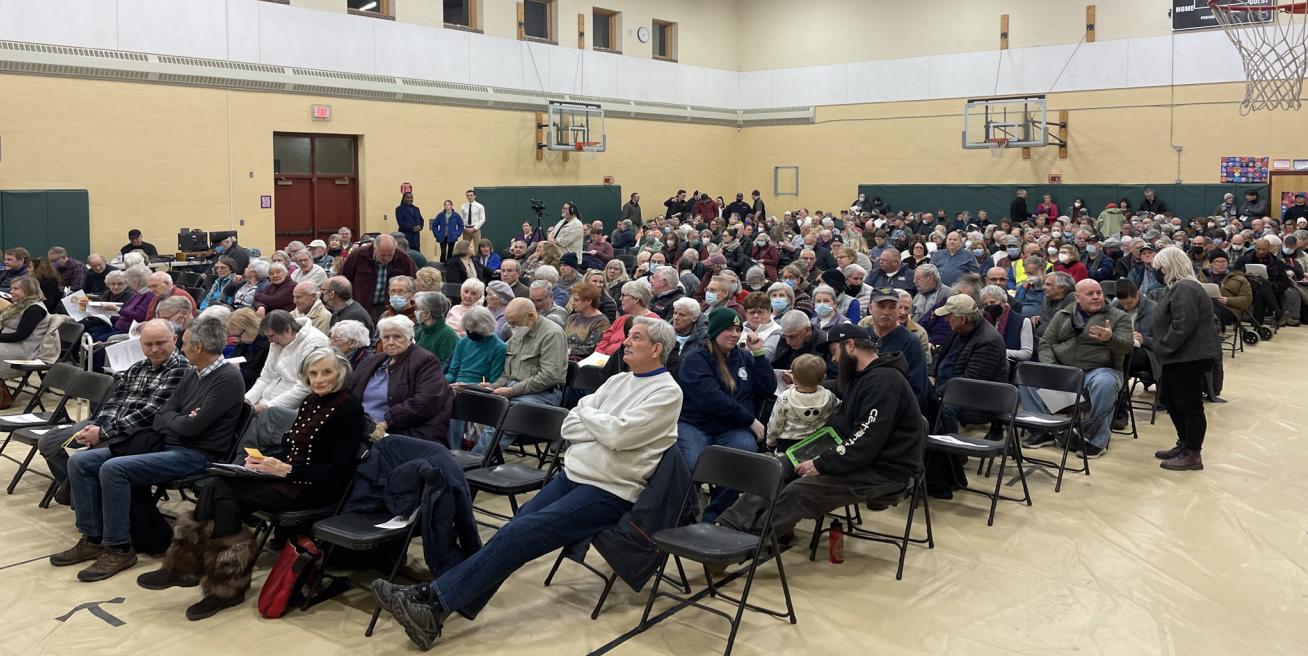Town voters approve $22.5 million fire station
March 1, 2023

Williamstown residents passed a proposal to build a new fire station at 562-580 Main Street in a 509-32 vote during yesterday’s special Town Meeting at the Williamstown Elementary School.
The building will replace the Town’s 73-year-old station, which falls short of numerous Occupational Safety and Health Administration (OSHA) and National Fire Protection Association standards. The Town did not hold any early voting or voting by mail and required a two-thirds majority for the proposal to pass.
Construction of the $22.5 million station will begin in the spring of 2024 and is expected to take roughly one year. The station will be paid for by two consecutive one-year notes, or shorter maturity bonds, and one 25-year bond, which will begin after the notes have been exhausted. The two notes are projected to increase property tax rates by 30 cents and 50 cents per $1,000 of property valuation respectively, and the subsequent bond is anticipated to increase property taxes by approximately $1 per $1,000 of property valuation.
At the beginning of the meeting, Dave Moresi, Prudential Committee Chair and member of the Fire District Building Committee, spoke briefly about the cost of the project, which he acknowledged would be a concern of many voters. “To move this project forward … we must vote to approve the entire project cost of $22.5 million dollars,” he said. “However — and this is a key point — the total amount the district will need to borrow and therefore appropriate from taxation will be reduced by applying all the grants that the district has received to date along with all future gifts and grants which we have still yet to realize.”
The estimates regarding tax revenue — created by a bond counsel firm with which the district partnered — take into consideration the College’s pledge of $5 million to the construction of the station. After the firm developed the estimates, though, the Williamstown Select Board committed $225,000 of the Town’s American Rescue Plan Act funds, and the Clark Art Institute dedicated another $500,000 to the project. Both contributions, as well as any state or federal grants the district may acquire, will ease the burden on taxpayers.
Currently, the Town’s firefighters, all of whom are volunteers, hose themselves down outdoors after returning from a call. They then reenter the station, where they wash their clothes in the laundry and clean their masks, which can become contaminated with the byproducts of combustion, hazardous biological matter, and pests such as fleas and lice.
But as of now, the only space for firefighters to wash their masks is the kitchen sink. “That sink — where we wash the masks that are covered in soot and all sorts of nasty stuff from fires — is the same sink we use when we clean our dishes and cook our dinners,” said Will Titus ’23, who started volunteering at the department as a first-year.
Since the station has no showers, firefighters also cannot rinse off combustion byproducts from fires at the station. These byproducts can then be absorbed into their bodies and increase the chance that they develop cancer, Fire District Building Committee Chair Elaine Neely said in an interview with the Record.
“We are grossly at fault for having such conditions,” Neely said. “These guys are going out into fires, coming in [the station], can’t really be decontaminated properly, getting into cars, driving home, and getting into their houses. How can we, in good conscience, allow that to happen?”
For firefighters’ safety, the new station will have designated contaminated and decontaminated spaces. The former area will have space for the general decontamination of gear, so firefighters will no longer have to hose themselves down outside. The contaminated area will also include specialized washers and extractors for equipment, showers, and increased storage space, limiting the amount of exposure gear will have to carcinogens in the station. The decontaminated area will include administrative, living, and public spaces, such as offices for the chief, deputy chief, and treasurer, as well as exercise and conference rooms.
In addition to the lack of isolated contaminated areas, the station falls short of OSHA standards for the separation of vehicles. OSHA requires vehicles to be eight feet apart, but the station — designed in the 1950s, when fire trucks were much smaller — is not large enough to accommodate that standard. The lack of space, Neely said, creates tripping hazards and puts firefighters attempting to exit the station in danger. “Because of the [station’s] size and the way the equipment is jammed in, it just takes longer to respond to a fire, so the community is at risk too,” she said. In the new station, the department’s vehicles will be housed in a larger and safer apparatus bay.
The station will also include a training space that doubles as an emergency operation center on its second floor. As of now, the Town’s firefighters train together on Monday nights, but the lack of space severely limits the types of drills they can run. “We don’t have enough room to practice the skills that we’re trying to practice, like search-and-rescues,” Titus said.
The station will be the Town’s first municipal building project since voters passed a resolution to pursue a net-zero greenhouse gas emissions goal in June 2021. It will be powered by solar panels and is designed to achieve a carbon-zero certification from the International Future Living Institute.
Members of the district have been discussing the construction of a new station since 2008. In 2013, a proposal to purchase the property where the station will be fell 13 votes short of passing. In 2017, the property came back on the market, and the district purchased it.
The original proposal called for a new station that cost $25 million and had a total area of 28,000 square feet. Because of feedback from community members who voiced concerns over the cost, however, the Town’s Prudential Committee capped the budget at $22.5 million in January. To accommodate the decrease in budget, the revised proposal called for a 22,485 square-foot station. It removed aspects of the initial design including the east wing of the building, which would have housed a training tower, as well as storage and conference rooms.
“[The district is] very disappointed that we went through the process of designing a fire station with engineers space by space by space, [learned] what our needs are and what the recommended size of that space would be done by industry standards, came up with a 28,000 square-foot building, and the community, who didn’t go through that process with us, is saying ‘It’s too big,’” Chief of the Fire Department Craig Pedercini said. “My personal opinion: They don’t know what they’re talking about.”
During the public comment section of the vote, Town resident Ben Lee Cohen asked about the risks of postponing or declining the proposal.
“If we did this 10 years ago, I guarantee you that the number that we are going to appropriate tonight would have been a heck of a lot less,” Moresi replied. “We all know the cost never goes down. It always goes up, and it’s unfortunate that we couldn’t have done this project 10 years ago. Now is the time.”
Town resident Gordon Squire said he voted against the proposal because of its cost, voicing concerns about a potential lack of state and federal financial support. “[The cost] is way beyond any realistic needs of the threat of fire in the community,” he said. “The funds are all going to come out of the hide of local taxpayers… The burdens will be tremendous.”
Anna Robertson, a financial assistant at the College’s department of athletics, voted in favor of the proposal. “I understand that people are concerned about the price tag, but it’s part of our pact with the community to help support people who keep us safe and keep our homes safe.”







